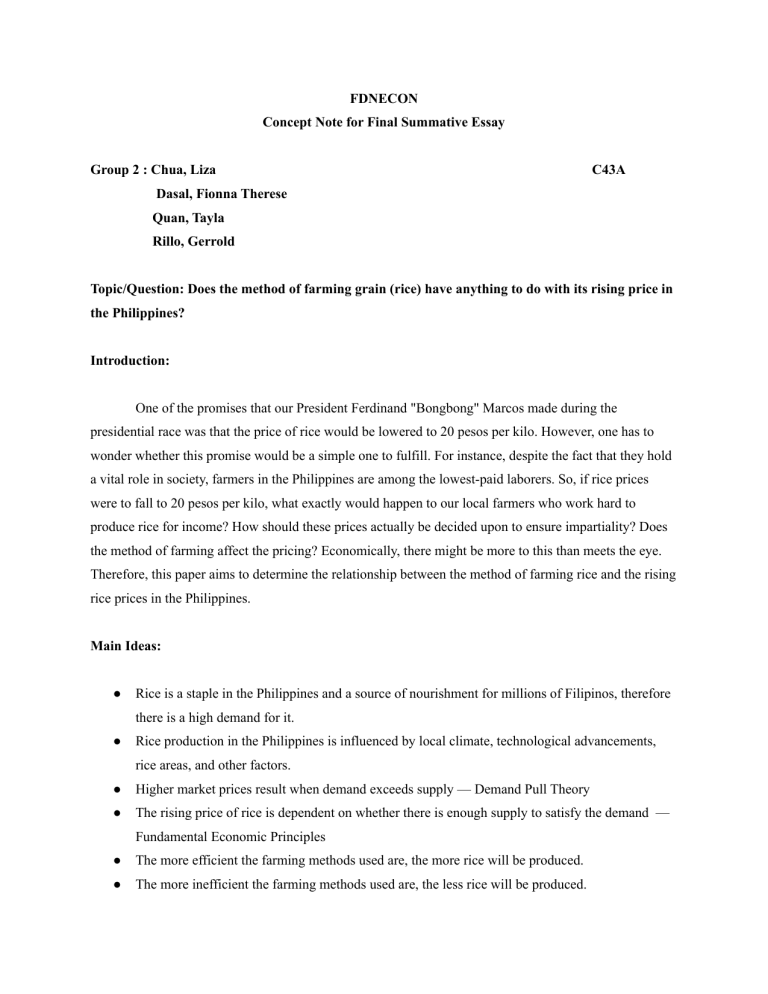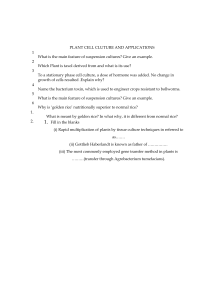
FDNECON Concept Note for Final Summative Essay Group 2 : Chua, Liza C43A Dasal, Fionna Therese Quan, Tayla Rillo, Gerrold Topic/Question: Does the method of farming grain (rice) have anything to do with its rising price in the Philippines? Introduction: One of the promises that our President Ferdinand "Bongbong" Marcos made during the presidential race was that the price of rice would be lowered to 20 pesos per kilo. However, one has to wonder whether this promise would be a simple one to fulfill. For instance, despite the fact that they hold a vital role in society, farmers in the Philippines are among the lowest-paid laborers. So, if rice prices were to fall to 20 pesos per kilo, what exactly would happen to our local farmers who work hard to produce rice for income? How should these prices actually be decided upon to ensure impartiality? Does the method of farming affect the pricing? Economically, there might be more to this than meets the eye. Therefore, this paper aims to determine the relationship between the method of farming rice and the rising rice prices in the Philippines. Main Ideas: ● Rice is a staple in the Philippines and a source of nourishment for millions of Filipinos, therefore there is a high demand for it. ● Rice production in the Philippines is influenced by local climate, technological advancements, rice areas, and other factors. ● Higher market prices result when demand exceeds supply — Demand Pull Theory ● The rising price of rice is dependent on whether there is enough supply to satisfy the demand — Fundamental Economic Principles ● The more efficient the farming methods used are, the more rice will be produced. ● The more inefficient the farming methods used are, the less rice will be produced. ● If the supply of rice grain goes down due to inadequate methods, it results in a higher price of rice in the market. References: IBON Foundation. (2020, November 1). Filipino rice farmers need support, not liberalization. https://www.ibon.org/filipino-rice-farmers-need-support-not-liberalization/?fbclid=IwAR 3Cui54XAhVC4x1VYCiLIBixGgeX7l_TK2PeNFUFbq0XDNLjMYEK2hqIQ8 Mamiit, R. J. (2021). Productivity Hot Spots and Cold Spots: Setting Geographic Priorities for Achieving Food Production Targets. Frontiers. https://www.frontiersin.org/articles/10.3389/fsufs.2021.727484/full Pelegrino, E. N. (2020, November 26). The importance of Rice to Filipinos’ lives . National Nutrition Council. https://nnc.gov.ph/regional-offices/mindanao/region-ix-zamboanga-peninsula/4387-the-i mportance-of-rice-to-filipinos-lives Romero, A. (2022, September 14). Marcos: Rice at P20 per kilo possible but not right away. Philstar Global. https://www.philstar.com/headlines/2022/09/14/2209687/marcos-rice-p20-pero-kilo-possi ble-not-right-away Farming Methods (Comparison of ph to other countries (Thai, Vietnam) ) in the conclusion, note that there are other factors that contribute to inefficiencies/low productivity of the ph rice production (i.e. irrigation, calamities, costs of fertilizer, etc)
